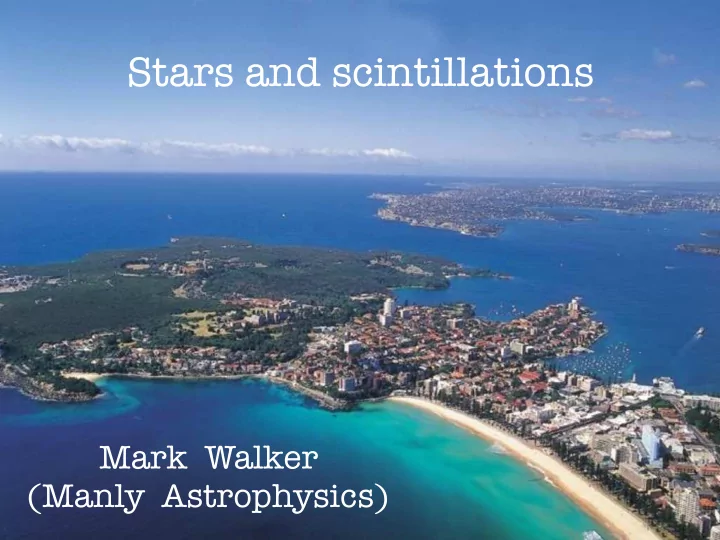

Stars and scintillations Mark Walker (Manly Astrophysics)
Overview Why is radio-wave propagation interesting? The ATESE project: who and what Discovery of Intra-Day Variability in PKS1322-110 Right next to Spica! Annual cycles in PKS1257-326 and J1819+3845 Association between IDV and local, hot stars News! Annual cycles in PKS1322-110 and J0437-4715 Inferences about the circumstellar medium Most stars are like the Helix Connections to other areas of astrophysics Manly Astrophysics
Why radio source scintillation is interesting A powerful “microscope” for the ionised ISM “Resolution” ∼ 10 11 cm (Fresnel scale) “Sensitivity” ∼ 10 11 cm -2 (Unit phase change) Usually see low-level flux variations of radio quasars Distributed turbulence throughout Galactic ISM (?) Sometimes see large, rapid flux variations Extreme Scattering Events (ESEs) - plasma lensing Intra-Day Variability (IDV) - scattering by plasma microstructure (highly anisotropic) ESEs/IDV suggest numerous small regions (10 1±1 AU) that are over-pressured (n e ∼ 10 2±1 cm -3 ) Manly Astrophysics
ATESE: ATCA survey for Extreme Scattering Events Keith Bannister (PI), Jamie Stevens, Simon Johnston, Hayley Bignall, Cormac Reynolds (CSIRO) - radio obs. Artem Tuntsov & MW (Manly) - theory + Vikram Ravi (Caltech) - optical follow-up Ran from April 2014 to October 2017 (Same team now studying fast scintillators) Monthly observations of 10 3 compact radio quasars Wide-band spectra (4 - 8 GHz) Intensive follow-up of interesting sources Mainly triggering on weird spectra Manly Astrophysics
First Event: PKS1939-315 Bannister ++ 2016 4 8 4 8 Radio Frequency (GHz) Manly Astrophysics
annister ++ 2016 Manly Astrophysics
PKS 1322-110 : a new IDV ATESE Team (2018) Manly Astrophysics
Spica PKS1322-110 Manly Astrophysics
PKS1257-326 (Hayley’s source) Bignall ++ 2003 Manly Astrophysics
PKS1257-326 (Hayley’s source) Bignall ++ 2003 1D 2D Manly Astrophysics
J1819+3845 (Jane’s source) Dennett-Thorpe and de Bruyn 2003 Manly Astrophysics
J1819+3845 (Jane’s source) Walker, de Bruyn & Bignall 2009 Manly Astrophysics
Bright stars in the foreground J1819+3845 PKS1257-326 Vega (A0V 7.7pc) Alhakim (A2V 18pc) Model: radial filaments, comoving with star Walker ++ 2017 Manly Astrophysics
Lucky coincidences? Fitting to annual cycle gives: Quasar 1. Orientation of plasma anisotropy 2. Perpendicular velocity component 3. Line-of-sight distance Hot star Scattering plasma hot star density = 4 ₒ 10 -4 pc -3 P = 2.4 ₒ 10 -5 (1819-Vega) P = 1.7 ₒ 10 -4 (1257-Alhakim) Walker ++ 2017 Manly Astrophysics
The environments of (hot) stars ₒ 10 5 ∼ 10 2 AU n e ∼ 10 cm -3 ∼ 1 pc Manly Astrophysics
Helix Nebula Manly Astrophysics
Helix Nebula Manly Astrophysics
Helix Nebula 9 0 0 2 a ++ m r u μ u 1 s t . a 2 M H 2 Total molecular mass ∼ M ⊙ Same for most stars ? Manly Astrophysics
These are likely H 2 snow clouds Example with M = 10 -4 M ⊙ ρ (H 2 +He) ρ (H 2 ) ρ ( * ) Walker & Wardle 2018 Manly Astrophysics
New picture of star formation 10 -5 M ⊙ 1 pc Collisions Manly Astrophysics
New picture of star formation Old galaxy 10 -5 M ⊙ 10 kpc Collisions Yields a simple model for M vis (Velocity) Walker 1999 Manly Astrophysics
Star-Cloud Interactions 1. Irradiation Thermal disruption (heating > cooling). Cometary tail of gas and H 2 dust. Possible manifestations? PNe cometary knots. SNe dust production events. B[e] stars. Wolf-Rayet “pinwheels”. O’Dell & Handron 1996 Tuthill++ 2008 Manly Astrophysics
Star-Cloud Interactions 2. Tidal Stripping Envelope easily stripped, core survives. Periodic events. Episodic accretion onto star - shocks, line emission. Some tidal debris escapes - stream of cold gas and H 2 dust. Obscuration events; blue-shifted absorption lines. Possible manifestations? Be stars R Cor Bor stars Manly Astrophysics
Summary Radio-wave scattering is mainly due to radial, circumstellar plasma filaments Now testing this model with QSOs and pulsars Six points of similarity to the plasma structures in the Helix Nebula Instigating deep searches for molecular counterparts Likely connections to a wide range of astrophysics Interstellar dust (H 2 snowflakes) Star and planet formation Many “stellar” phenomena Wolf Rayet, Be stars, R Cor Bor, etc Galaxy formation and evolution; early universe etc Manly Astrophysics
Recommend
More recommend